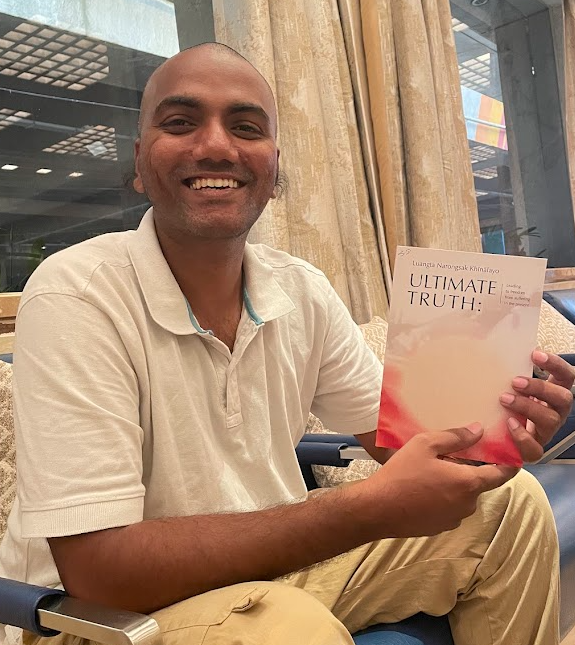1989:
Born in Sarvodaya Hospital, Ghatkopar, amidst idols of many gods, earning the loving label of "God boy".
1990:
Received immense affection from a multicultural neighbourhood, an early lesson in unity.
1991:
My childhood explorations, often following animals, taught me early lessons in compassion, thanks to my parents.
1992:
Witnessed the deep wounds of civic discord during the Mumbai riots, planting the seeds of my search for peace.
1993:
Began early schooling at Kendriya Child School, my first formal interaction with India's diverse cultures.
1994:
A visit to Mumbai Airport with my father opened my eyes to a world beyond my city and language.
1995:
Started 1st standard, where my teacher Mrs. Manjarekar kindled my love for Maths and Science.
1996:
An adventurous solo bus trip ended with a calming interaction with police, teaching me about gentle authority.
1997:
Observed societal polarization firsthand, while annual pilgrimages with family built my ethical foundation.
1998:
Briefly swayed by negative influences, a crucial life lesson about the importance of good company.
1999:
The deep impact of these influences led my parents to decide to shift our family to Badlapur for a better environment.
2000:
A year of transition, as my parents debated the move, fearing the negative cultural impact on their sons.
2001:
Finally shifted to my mother's childhood city, Badlapur, where my personal inclination towards peace began to blossom.
2002:
Started organising religious festivals like Ganesh Utsav to foster community interaction and family spirit.
2003:
My first entrepreneurial venture—a lemon water stall—taught me customer service, patience, and how to handle negativity at age 14.
2004:
Witnessed a small dispute over a cricket ball erupt into a brutal fight, cementing my belief in dialogue over argument.
2005:
Passed SSC with First Class. Survived the traumatic Mumbai floods, experiencing the profound power of community compassion.
2006:
Passed 11th Science and was awarded "Student of the Year" in college, beginning my study of the science behind emotions.
2007:
Passed 12th Science and was chosen as the Science stream's representative. Began my BSc in Computer Science at CHM College.
2008:
Became Joint General Secretary of the Science Association, guided by Dr. Bhavna Motwani's ethos: "be an employer, not an employee".
2009:
As Class Secretary, I delivered my first live software projects for real clients, a unique achievement for a student.
2010:
Graduated with a BSc in Computer Science, thanks to the guidance of HOD Dr. Ritika Sachdev madam.
2011:
Chosen as Student President for the "Aadarsh Mahamelava", a grand 50-year alumni meet for my school.
2012:
The profound loss of my mother became a catalyst for understanding attachment and the preciousness of life.
2013:
Launched my own ISP business, ACWS GLOBAL INTERNET, and was invited to the Reseller Club event.
2014:
Engaged in community work, distributing school bags and books to children in need.
2015:
Co-founded "The Young Scientist Den". A visit to the Lotus Temple in Delhi ignited my formal path into meditation.
2016:
Completed my MSc Part 1. A visit to the Global Vipassana Pagoda solidified my interest in this profound technique.
2017:
Completed my MSc in Computer Science. Successfully counseled a suicidal student, affirming a new life-purpose in mental well-being.
2018:
My "second birth": attended my first 10-day Vipassana course, finding a clear purpose for my life in promoting peace.
2019:
Conducted over 20 Anapana meditation workshops across cities and tribal areas for thousands of students.
2020:
Completed my first long course (TSC). Led extensive community aid efforts during the COVID-19 pandemic.
2021:
Navigated immense personal challenges during the second COVID wave, reinforcing lessons on impermanence and selfless service.
2022:
Welcomed my daughter, Kishu. Completed a 20-day long course and began regular monthly Dhamma service at Khadavli center.
2023:
Established Ataraxia Yoga. Continued to resolve student conflicts through peaceful dialogue upon request from local colleges.
2024:
Volunteered for a 7-day teenager's course, guiding over 70 students. Navigated a major school crisis with compassion as a media representative.
2025:
Organised a large-scale sky gazing event for 500+ students with TIFR scholars. Began my formal studies in Psychology at the prestigious Elphinstone College, Mumbai.

